|
 Hygrocybe lilaceolamellata Hygrocybe lilaceolamellata
SynonymsHygrophorus lilaceolamellatus
Hygrocybe lilaceolamellata
BiostatusPresent in region - Indigenous. Endemic
Images (click to enlarge)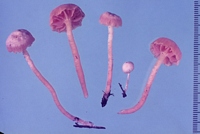
Owner: Herb. PDD | 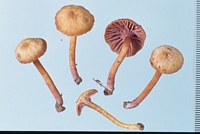
Owner: Herb. PDD | 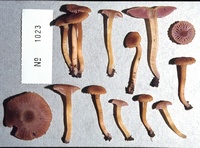
Caption: ZT1023
Owner: E. Horak: © Creative Commons Attribution-Noncommercial 3.0 New Zealand | 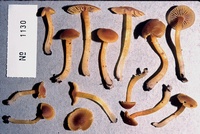
Caption: ZT1130
Owner: E. Horak: © Creative Commons Attribution-Noncommercial 3.0 New Zealand | 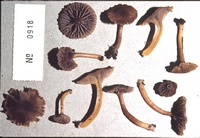
Caption: ZT0918
Owner: E. Horak: © Creative Commons Attribution-Noncommercial 3.0 New Zealand | 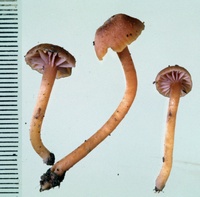
Caption: ZT0747
Owner: E. Horak: © Creative Commons Attribution-Noncommercial 3.0 New Zealand | 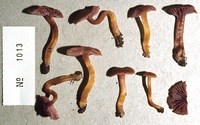
Caption: ZT1013
Owner: E. Horak: © Creative Commons Attribution-Noncommercial 3.0 New Zealand | 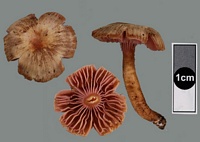
Owner: J.A. Cooper | 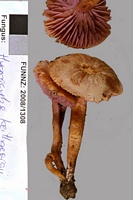
Owner: J.A. Cooper | 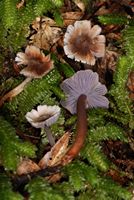
Owner: J.A. Cooper | 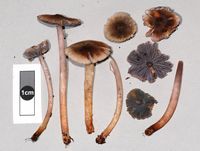
Owner: J.A. Cooper | 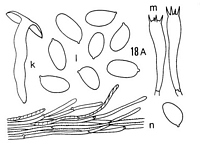
Caption: Hygrocybe lilaceolamellata (Stev.) (type): k. carpophore. - 1. spores. - m. basidia. - n. cuticle | 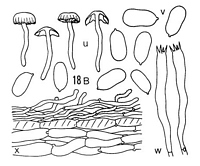
Caption: B: Hygrocybe lilaceolamellata (Stev.): u. carpophores. - v. spores. - w. basidia. - x. cuticle (Herb. HK. ZT 68/559) | 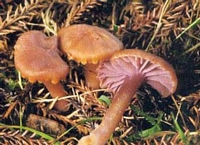
Caption: Hygrocybe lilaceolamellata
Owner: Kaimai Bush | 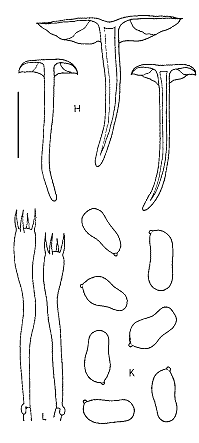
Caption: Fig 12 Hygrocybe lilaceolamellata (Stev.) Horak (H-L: ZT- 1023):
H. basidiomes. K. spores. L. basidia. | 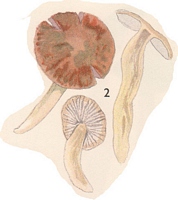 | 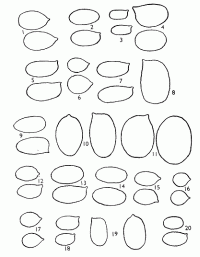
Caption: Spores X 2000 1. Hygrophorus salmonipes 2; H. elsae; 3, H .julietae; 4, H. variabilis; 5, H. lilaceo-lamelllatus; 6, H. muritaiensis; 7, H. keithgeorgei; 8, H. pseudococcineus; 9, H. rubro-carnosus; 10, H. miniceps; 11, H. procerus; 12, H. multic |
Article: Horak, E. (1990). Monograph of the New Zealand Hygrophoraceae (Agaricales). New Zealand Journal of Botany 28(3): 255-306 (http://www.rsnz.org/publish/abstracts.php).
Description: Pileus 40 mm, hemispherical soon becoming convex, centre flat to depressed,
margin occasionally upturned in aged basidiomes; orange-brown or honey brown,
disc distinctly red-brown, fading with age; viscid when moist, dry becoming
innately fibrillose, conspicuously striate and often sulcate at margin, hygrophanous.
- Lamellae 8-16 (1-3) distant to crowded, broadly adnate to decurrent, ± triangular,
up to 6 mm wide; brilliant lilac to violaceous, occasionally with dark brown
to olive tint, edges concolorous, entire. - Stipe 20-50 x 2-6 mm, cylindrical,
equal but often attenuated at base; concolorous with pileus, paler at base (occasionally
with lilac tint); dry, silky to fibrillose, occasionally strigose at base, hollow,
single or caespitose. - Context orange-brown in pileus and stipe, rarely with
lilac or olive tints. - Odour and taste not distinctive. - Chemical reactions
on pileus unknown.
Spores 7-9 (-9.5) x 3.5-5 um, ellipsoid to pear-shaped with distinct constriction.
- Basidia 35-70 x 6-8 um, 4-spored. - Cystidia absent - Pileipellis an ixocutis
of cylindrical, interwoven hyphae (3-6 um diam.), membranes gelatinised, with
yellowish (KOH) plasmatic and encrusting pigment; clamp connections present
(Pl.l, Fig.7).
Habitat: ECOLOGY: Common; saprobic on soil among litter in broadleaved-conifer forests
(Leptospermum, Weinmannia, Metrosideros, Beilschmiedia) with tree ferns
(Dicksonia, Cyathea). May-July.
Distribution: DISTRIBUTION: NZ (NA,T,W).
Article: Horak, E. (1971). A contribution towards the revision of the Agaricales (Fungi) from New Zealand. New Zealand Journal of Botany 9(3): 403-462 (http://www.rsnz.org/publish/abstracts.php).
Notes: Hygrophorus lilaceo-lamellatus Stevenson (28 D) = Hygrocybe lilaceo-lamellatus (Stevenson) comb. nov.
(Basionym: H. lilaceo-lamellatus Stevenson,
Kew Bull. 16: 378, 1962)
Article: Stevenson, G. (1963) [1962]. The Agaricales of New Zealand: IV. Kew Bulletin 16(3): 373–384.
Description: Pileus 1.5-3 cm. diam., fulvous, planoconvex
becoming concave and radially split, moist, waxy, becoming cottony striate when
dry; flesh thin, yellowish. Gills adnate, lilac tinged with yellow, moderately
distant, thick, with veins between. Stipe 2-5 cm. X 5-6 mm., ochraceous, paler
at base, with whitish silky striations, hollow, flesh greenish yellow. Spores
10-11 X 5-5.5µm., oblong, hyaline, thin-walled. Basidia 40 X 5µm., four-spored.
Habitat: habitat: terrestrial under mixed scrub, Wellington Botanic Garden,
2.6.1949, Stevenson.
Article: Horak, E. (1973). Fungi Agaricini Novazelandiae I-V. Beihefte zur Nova Hedwigia 43: 200 p.
Description: Pileus 10-30 mm diam., hemispherical later becoming plano-convex, reddish brown when moist fading to fulvous, viscid, innately fibrillose or (in aged carpophores) appressed squamulose, striated near the margin. Lamellae adnate to subdecurrent, lilac to violaceous, distant, rather thick, gill edge concolorous, even. Stipe 20-50 x 2-6 mm, cylindric, equal, concolorous with pileus fading to ochraceous, dry, silky, flexuous, hollow. Context in pileus brownish-orange, yellowish in stipe. Taste and odor not distinctive. Chemical reactions on pileus: unknown.
Spores 7-9.5 x 3.5-5 µm, ellipsoid, sometimes constricted and pyriform, smooth, inamyloid. Basidia 35-55 x 6-8µ, 4-spored. Cystidia absent. Cuticle a cutis of repent, cylindric, hyaline hyphae (3-6 µm diam.), pigment plasmatic and encrusting the ungelatinized membranes. Clamp connections present.
Habitat: In soil amongst litter of Weinmannia, Beilschmiedia, Metrosideros, Cyathea, etc. New Zealand.
Notes: Fresh carpophores of this species resemble in stature and colours a degraded form of Laccaria laccata (Fr.) or L. amethystina (Bolt. ex Hooker). On drying the reddish brown colour fades especially on the pileus but the lilac tints remain on the lamellae and the upper portion of the stipe. According to the original description given by Stevenson there is a close relationship between this N.Z. species and 2 other species of Hygrocybe from the southern parts of South America: H. laccarioides Singer (1952) collected in Fireland and H. lateritiorosella Singer (1969) from Chile. Further studies are necessary to get more information about their interspecific relationships.
|